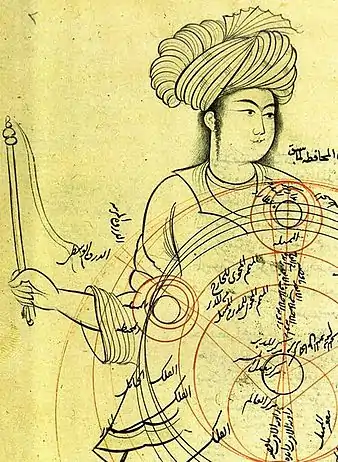Astronomy in the medieval Islamic world
Islamic astronomy comprises the astronomical developments made in the Islamic world, particularly during the Islamic Golden Age (9th–13th centuries),[1] and mostly written in the Arabic language. These developments mostly took place in the Middle East, Central Asia, Al-Andalus, and North Africa, and later in the Far East and India. It closely parallels the genesis of other Islamic sciences in its assimilation of foreign material and the amalgamation of the disparate elements of that material to create a science with Islamic characteristics. These included Greek, Sassanid, and Indian works in particular, which were translated and built upon.[2]
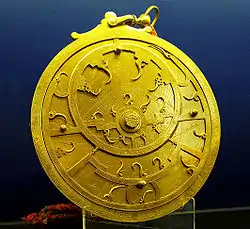
Islamic astronomy played a significant role in the revival of Byzantine[3] and European[4] astronomy following the loss of knowledge during the early medieval period, notably with the production of Latin translations of Arabic works during the 12th century. Islamic astronomy also had an influence on Chinese astronomy[5] and Malian astronomy.[6][7]
A significant number of stars in the sky, such as Aldebaran, Altair and Deneb, and astronomical terms such as alidade, azimuth, and nadir, are still referred to by their Arabic names.[8][9] A large corpus of literature from Islamic astronomy remains today, numbering approximately 10,000 manuscripts scattered throughout the world, many of which have not been read or catalogued. Even so, a reasonably accurate picture of Islamic activity in the field of astronomy can be reconstructed.[10]
Pre-Islamic Arabs
Ahmad Dallal notes that, unlike the Babylonians, Greeks, and Indians, who had developed elaborate systems of mathematical astronomical study, the pre-Islamic Arabs relied entirely on empirical observations. These observations were based on the rising and setting of particular stars, and this area of astronomical study was known as anwa. Anwa continued to be developed after Islamization by the Arabs, where Islamic astronomers added mathematical methods to their empirical observations.[11]
Early Islam
Following the Islamic conquests, under the early caliphate, Muslim scholars began to absorb Hellenistic and Indian astronomical knowledge via translations into Arabic (in some cases via Persian).
The first astronomical texts that were translated into Arabic were of Indian[12] and Persian origin.[13] The most notable of the texts was Zij al-Sindhind,[lower-alpha 1] an 8th-century Indian astronomical work that was translated by Muhammad ibn Ibrahim al-Fazari and Yaqub ibn Tariq after 770 CE with the assistance of Indian astronomers who visited the court of caliph Al-Mansur in 770.[12] Another text translated was the Zij al-Shah, a collection of astronomical tables (based on Indian parameters) compiled in Sasanid Persia over two centuries. Fragments of texts during this period indicate that Arabs adopted the sine function (inherited from India) in place of the chords of arc used in Greek trigonometry.[11]
According to David King, after the rise of Islam, the religious obligation to determine the qibla and prayer times inspired progress in astronomy.[14] Early Islam's history shows evidence of a productive relationship between faith and science. Specifically, Islamic scientists took an early interest in astronomy, as the concept of keeping time accurately was important for the five daily prayers central to the faith. Early Islamicate scientists constructed astronomical tables specifically to determine the exact times of prayer for specific locations around the continent, serving effectively as an early system of time zones.[15]
Golden Age
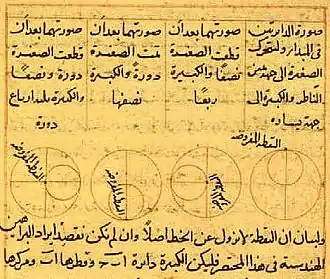
The House of Wisdom was an academy established in Baghdad under Abbasid caliph Al-Ma'mun in the early 9th century. Astronomical research was greatly supported by the Abbasid caliph al-Mamun through the House of Wisdom. Baghdad and Damascus became the centers of such activity.
The first major Muslim work of astronomy was Zij al-Sindhind by Persian mathematician al-Khwarizmi in 830. The work contains tables for the movements of the Sun, the Moon and the five planets known at the time. The work is significant as it introduced Ptolemaic concepts into Islamic sciences. This work also marks the turning point in Islamic astronomy. Hitherto, Muslim astronomers had adopted a primarily research approach to the field, translating works of others and learning already discovered knowledge. Al-Khwarizmi's work marked the beginning of nontraditional methods of study and calculations.[16]
Doubts on Ptolemy
In 850, al-Farghani wrote Kitab fi Jawami (meaning "A compendium of the science of stars"). The book primarily gave a summary of Ptolemic cosmography. However, it also corrected Ptolemy based on findings of earlier Arab astronomers. Al-Farghani gave revised values for the obliquity of the ecliptic, the precessional movement of the apogees of the Sun and the Moon, and the circumference of the Earth. The book was widely circulated through the Muslim world, and translated into Latin.[17]
By the 10th century texts appeared regularly whose subject matter was doubts concerning Ptolemy (shukūk).[18] Several Muslim scholars questioned the Earth's apparent immobility[19][20] and centrality within the universe.[21] From this time, independent investigation into the Ptolemaic system became possible. According to Dallal (2010), the use of parameters, sources and calculation methods from different scientific traditions made the Ptolemaic tradition "receptive right from the beginning to the possibility of observational refinement and mathematical restructuring".[22]
Egyptian astronomer Ibn Yunus found fault in Ptolemy's calculations about the planet's movements and their peculiarity in the late 10th century. Ptolemy calculated that Earth's wobble, otherwise known as precession, varied 1 degree every 100 years. Ibn Yunus contradicted this finding by calculating that it was instead 1 degree every 701⁄4 years.
Between 1025 and 1028, Ibn al-Haytham wrote his Al-Shukuk ala Batlamyus (meaning "Doubts on Ptolemy"). While maintaining the physical reality of the geocentric model, he criticized elements of the Ptolemic models. Many astronomers took up the challenge posed in this work, namely to develop alternate models that resolved these difficulties. In 1070, Abu Ubayd al-Juzjani published the Tarik al-Aflak where he discussed the "equant" problem of the Ptolemic model and proposed a solution. In Al-Andalus, the anonymous work al-Istidrak ala Batlamyus (meaning "Recapitulation regarding Ptolemy"), included a list of objections to the Ptolemic astronomy.
Nasir al-Din al-Tusi, the creator of the Tusi Couple, also worked heavily to expose the problems present in Ptolemy's work. In 1261, Tusi published his Tadkhira, which contained 16 fundamental problems he found with Ptolemaic astronomy,[23] and by doing this, set off a chain of Islamic scholars that would attempt to solve these problems. Scholars such as Qutb al-Din al-Shirazi, Ibn al-Shatir, and Shams al-Din al-Khafri all worked to produce new models for solving Tusi's 16 Problems,[24] and the models they worked to create would become widely adopted by astronomers for use in their own works.
Earth rotation
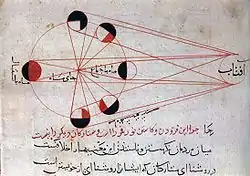
Abu Rayhan Biruni (b. 973) discussed the possibility of whether the Earth rotated about its own axis and around the Sun, but in his Masudic Canon, he set forth the principles that the Earth is at the center of the universe and that it has no motion of its own.[25] He was aware that if the Earth rotated on its axis, this would be consistent with his astronomical parameters,[26] but he considered this a problem of natural philosophy rather than mathematics.[27][4]
His contemporary, Abu Sa'id al-Sijzi, accepted that the Earth rotates around its axis.[28] Al-Biruni described an astrolabe invented by Sijzi based on the idea that the earth rotates:
I have seen the astrolabe called Zuraqi invented by Abu Sa'id Sijzi. I liked it very much and praised him a great deal, as it is based on the idea entertained by some to the effect that the motion we see is due to the Earth's movement and not to that of the sky. By my life, it is a problem difficult of solution and refutation. [...] For it is the same whether you take it that the Earth is in motion or the sky. For, in both cases, it does not affect the Astronomical Science. It is just for the physicist to see if it is possible to refute it.[29]
The fact that some people did believe that the earth is moving on its own axis is further confirmed by an Arabic reference work from the 13th century which states:
According to the geometers [or engineers] (muhandisīn), the earth is in constant circular motion, and what appears to be the motion of the heavens is actually due to the motion of the earth and not the stars.[27]
At the Maragha and Samarkand observatories, the Earth's rotation was discussed by al-Kātibī (d. 1277),[30] Tusi (b. 1201) and Qushji (b. 1403). The arguments and evidence used by Tusi and Qushji resemble those used by Copernicus to support the Earth's motion.[19][20] However, it remains a fact that the Maragha school never made the big leap to heliocentrism.[31]
Alternative geocentric systems
In the 12th century, non-heliocentric alternatives to the Ptolemaic system were developed by some Islamic astronomers in al-Andalus, following a tradition established by Ibn Bajjah, Ibn Tufail, and Ibn Rushd.
A notable example is Nur ad-Din al-Bitruji, who considered the Ptolemaic model mathematical, and not physical.[32][33] Al-Bitruji proposed a theory on planetary motion in which he wished to avoid both epicycles and eccentrics.[34] He was unsuccessful in replacing Ptolemy's planetary model, as the numerical predictions of the planetary positions in his configuration were less accurate than those of the Ptolemaic model.[35] One original aspects of al-Bitruji's system is his proposal of a physical cause of celestial motions. He contradicts the Aristotelian idea that there is a specific kind of dynamics for each world, applying instead the same dynamics to the sublunar and the celestial worlds.[36]
Later period
In the late thirteenth century, Nasir al-Din al-Tusi created the Tusi couple, as pictured above. Other notable astronomers from the later medieval period include Mu'ayyad al-Din al-'Urdi (c. 1266), Qutb al-Din al Shirazi (c. 1311), Sadr al-Sharia al-Bukhari (c. 1347), Ibn al-Shatir (c. 1375), and Ali al-Qushji (c. 1474).[37]
In the fifteenth century, the Timurid ruler Ulugh Beg of Samarkand established his court as a center of patronage for astronomy. He studied it in his youth, and in 1420 ordered the construction of Ulugh Beg Observatory, which produced a new set of astronomical tables, as well as contributing to other scientific and mathematical advances.[38]
Several major astronomical works were produced in the early 16th century, including ones by 'Abd al-Ali al-Birjandi (d. 1525 or 1526) and Shams al-Din al-Khafri (fl. 1525). However, the vast majority of works written in this and later periods in the history of Islamic sciences are yet to be studied.[20]
Influences
Europe
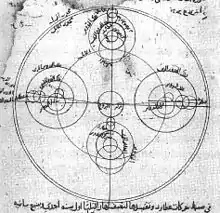
Several works of Islamic astronomy were translated to Latin starting from the 12th century.
The work of al-Battani (d. 929), Kitāb az-Zīj ("Book of Astronomical Tables"), was frequently cited by European astronomers and received several reprints, including one with annotations by Regiomontanus.[39] Copernicus, in his book that initiated the Copernican Revolution, the De Revolutionibus Orbium Coelestium, mentioned al-Battani no fewer than 23 times,[40] and also mentions him in the Commentariolus.[41] Tycho Brahe, Riccioli, Kepler, Galileo and others frequently cited him or his observations.[42] His data is still used in geophysics.[43]
Around 1190, Al-Bitruji published an alternative geocentric system to Ptolemy's model. His system spread through most of Europe during the 13th century, with debates and refutations of his ideas continued to the 16th century.[44] In 1217, Michael Scot finished a Latin translation of al-Bitruji's Book of Cosmology (Kitāb al-Hayʾah), which became a valid alternative to Ptolemy's Almagest in scholastic circles.[36] Several European writers, including Albertus Magnus and Roger Bacon, explained it in detail and compared it with Ptolemy's.[44] Copernicus cited his system in the De revolutionibus while discussing theories of the order of the inferior planets.[44][36]
Some historians maintain that the thought of the Maragheh observatory, in particular the mathematical devices known as the Urdi lemma and the Tusi couple, influenced Renaissance-era European astronomy and thus Copernicus.[4][45][46][47][48] Copernicus used such devices in the same planetary models as found in Arabic sources.[49] Furthermore, the exact replacement of the equant by two epicycles used by Copernicus in the Commentariolus was found in an earlier work by Ibn al-Shatir (d. c. 1375) of Damascus.[50] Copernicus' lunar and Mercury models are also identical to Ibn al-Shatir's.[51]
While the influence of the criticism of Ptolemy by Averroes on Renaissance thought is clear and explicit, the claim of direct influence of the Maragha school, postulated by Otto E. Neugebauer in 1957, remains an open question.[31][52][53] Since the Tusi couple was used by Copernicus in his reformulation of mathematical astronomy, there is a growing consensus that he became aware of this idea in some way. It has been suggested[54][55] that the idea of the Tusi couple may have arrived in Europe leaving few manuscript traces, since it could have occurred without the translation of any Arabic text into Latin. One possible route of transmission may have been through Byzantine science, which translated some of al-Tusi's works from Arabic into Byzantine Greek. Several Byzantine Greek manuscripts containing the Tusi-couple are still extant in Italy.[56] Other scholars have argued that Copernicus could well have developed these ideas independently of the late Islamic tradition.[57] Copernicus explicitly references several astronomers of the "Islamic Golden Age" (10th to 12th centuries) in De Revolutionibus: Albategnius (Al-Battani), Averroes (Ibn Rushd), Thebit (Thabit Ibn Qurra), Arzachel (Al-Zarqali), and Alpetragius (Al-Bitruji), but he does not show awareness of the existence of any of the later astronomers of the Maragha school.[41]
It has been argued that Copernicus could have independently discovered the Tusi couple or took the idea from Proclus's Commentary on the First Book of Euclid,[58] which Copernicus cited.[59] Another possible source for Copernicus's knowledge of this mathematical device is the Questiones de Spera of Nicole Oresme, who described how a reciprocating linear motion of a celestial body could be produced by a combination of circular motions similar to those proposed by al-Tusi.[60]
China
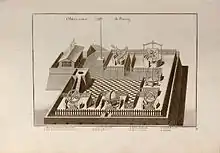
Islamic influence on Chinese astronomy was first recorded during the Song dynasty when a Hui Muslim astronomer named Ma Yize introduced the concept of seven days in a week and made other contributions.[61]
Islamic astronomers were brought to China in order to work on calendar making and astronomy during the Mongol Empire and the succeeding Yuan Dynasty.[62][63] The Chinese scholar Yeh-lu Chu'tsai accompanied Genghis Khan to Persia in 1210 and studied their calendar for use in the Mongol Empire.[63] Kublai Khan brought Iranians to Beijing to construct an observatory and an institution for astronomical studies.[62]
Several Chinese astronomers worked at the Maragheh observatory, founded by Nasir al-Din al-Tusi in 1259 under the patronage of Hulagu Khan in Persia.[64] One of these Chinese astronomers was Fu Mengchi, or Fu Mezhai.[65] In 1267, the Persian astronomer Jamal ad-Din, who previously worked at Maragha observatory, presented Kublai Khan with seven Persian astronomical instruments, including a terrestrial globe and an armillary sphere,[66] as well as an astronomical almanac, which was later known in China as the Wannian Li ("Ten Thousand Year Calendar" or "Eternal Calendar"). He was known as "Zhamaluding" in China, where, in 1271,[65] he was appointed by Khan as the first director of the Islamic observatory in Beijing,[64] known as the Islamic Astronomical Bureau, which operated alongside the Chinese Astronomical Bureau for four centuries. Islamic astronomy gained a good reputation in China for its theory of planetary latitudes, which did not exist in Chinese astronomy at the time, and for its accurate prediction of eclipses.[5]
Some of the astronomical instruments constructed by the famous Chinese astronomer Guo Shoujing shortly afterwards resemble the style of instrumentation built at Maragheh.[64] In particular, the "simplified instrument" (jianyi) and the large gnomon at the Gaocheng Astronomical Observatory show traces of Islamic influence.[5] While formulating the Shoushili calendar in 1281, Shoujing's work in spherical trigonometry may have also been partially influenced by Islamic mathematics, which was largely accepted at Kublai's court.[67] These possible influences include a pseudo-geometrical method for converting between equatorial and ecliptic coordinates, the systematic use of decimals in the underlying parameters, and the application of cubic interpolation in the calculation of the irregularity in the planetary motions.[5]
Hongwu Emperor (r. 1368-1398) of the Ming Dynasty (1328–1398), in the first year of his reign (1368), conscripted Han and non-Han astrology specialists from the astronomical institutions in Beijing of the former Mongolian Yuan to Nanjing to become officials of the newly established national observatory.
That year, the Ming government summoned for the first time the astronomical officials to come south from the upper capital of Yuan. There were fourteen of them. In order to enhance accuracy in methods of observation and computation, Hongwu Emperor reinforced the adoption of parallel calendar systems, the Han and the Hui. In the following years, the Ming Court appointed several Hui astrologers to hold high positions in the Imperial Observatory. They wrote many books on Islamic astronomy and also manufactured astronomical equipment based on the Islamic system.
The translation of two important works into Chinese was completed in 1383: Zij (1366) and al-Madkhal fi Sina'at Ahkam al-Nujum, Introduction to Astrology (1004).
In 1384, a Chinese astrolabe was made for observing stars based on the instructions for making multi-purposed Islamic equipment. In 1385, the apparatus was installed on a hill in northern Nanjing.
Around 1384, during the Ming Dynasty, Hongwu Emperor ordered the Chinese translation and compilation of Islamic astronomical tables, a task that was carried out by the scholars Mashayihei, a Muslim astronomer, and Wu Bozong, a Chinese scholar-official. These tables came to be known as the Huihui Lifa (Muslim System of Calendrical Astronomy), which was published in China a number of times until the early 18th century,[68] though the Qing Dynasty had officially abandoned the tradition of Chinese-Islamic astronomy in 1659.[69] The Muslim astronomer Yang Guangxian was known for his attacks on the Jesuit's astronomical sciences.
Korea
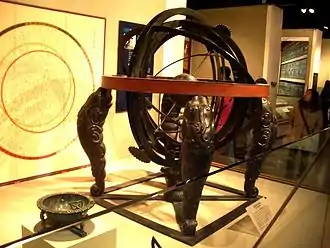
In the early Joseon period, the Islamic calendar served as a basis for calendar reform being more accurate than the existing Chinese-based calendars.[70] A Korean translation of the Huihui Lifa, a text combining Chinese astronomy with Islamic astronomy works of Jamal ad-Din, was studied in Korea under the Joseon Dynasty during the time of Sejong in the fifteenth century.[71] The tradition of Chinese-Islamic astronomy survived in Korea up until the early nineteenth century.[69]
Observatories
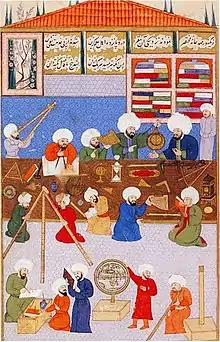
The first systematic observations in Islam are reported to have taken place under the patronage of al-Mamun. Here, and in many other private observatories from Damascus to Baghdad, meridian degrees were measured, solar parameters were established, and detailed observations of the Sun, Moon, and planets were undertaken.
In the tenth century, the Buwayhid dynasty encouraged the undertaking of extensive works in astronomy, such as the construction of a large-scale instrument with which observations were made in the year 950. We know of this by recordings made in the zij of astronomers such as Ibn al-Alam. The great astronomer Abd Al-Rahman Al Sufi was patronised by prince Adud o-dowleh, who systematically revised Ptolemy's catalogue of stars. Sharaf al-Daula also established a similar observatory in Baghdad. Reports by Ibn Yunus and al-Zarqall in Toledo and Cordoba indicate the use of sophisticated instruments for their time.
It was Malik Shah I who established the first large observatory, probably in Isfahan. It was here where Omar Khayyám with many other collaborators constructed a zij and formulated the Persian Solar Calendar a.k.a. the jalali calendar. A modern version of this calendar is still in official use in Iran today.
The most influential observatory was however founded by Hulegu Khan during the thirteenth century. Here, Nasir al-Din al-Tusi supervised its technical construction at Maragha. The facility contained resting quarters for Hulagu Khan, as well as a library and mosque. Some of the top astronomers of the day gathered there, and from their collaboration resulted important modifications to the Ptolemaic system over a period of 50 years.
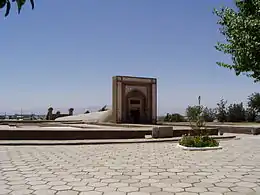
In 1420, prince Ulugh Beg, himself an astronomer and mathematician, founded another large observatory in Samarkand, the remains of which were excavated in 1908 by Russian teams.
And finally, Taqi al-Din Muhammad ibn Ma'ruf founded a large observatory in Ottoman Constantinople in 1577, which was on the same scale as those in Maragha and Samarkand. The observatory was short-lived however, as opponents of the observatory and prognostication from the heavens prevailed and the observatory was destroyed in 1580.[72] While the Ottoman clergy did not object to the science of astronomy, the observatory was primarily being used for astrology, which they did oppose, and successfully sought its destruction.[73]
As observatory development continued, Islamicate scientists began to pioneer the planetarium. The major difference between a planetarium and an observatory is how the universe is projected. In an observatory, you must look up into the night sky, on the other hand, planetariums allow for universes planets and stars to project at eye-level in a room. Scientist Ibn Firnas, created a planetarium in his home that included artificial storm noises and was completely made of glass. Being the first of its kind, it very similar to what we see for planetariums today.
Instruments
Our knowledge of the instruments used by Muslim astronomers primarily comes from two sources: first the remaining instruments in private and museum collections today, and second the treatises and manuscripts preserved from the Middle Ages. Muslim astronomers of the "Golden Period" made many improvements to instruments already in use before their time, such as adding new scales or details.
Celestial globes and armillary spheres
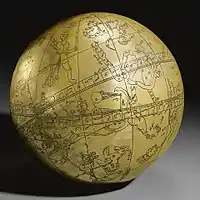
Celestial globes were used primarily for solving problems in celestial astronomy. Today, 126 such instruments remain worldwide, the oldest from the 11th century. The altitude of the Sun, or the Right Ascension and Declination of stars could be calculated with these by inputting the location of the observer on the meridian ring of the globe. The initial blueprint for a portable celestial globe to measure celestial coordinates came from Spanish Muslim astronomer Jabir ibn Aflah (d. 1145). Another skillful Muslim astronomer working on celestial globes was ‘Abd al-Rahman al-Sufi(b. 903), whose treatise describes how to design the constellation images on the globe, as well as how to use the celestial globe. However, it was in Iraq in the 10th century that astronomer Al-Battani was working on celestial globes to record celestial data. This was different because up until then, the traditional use for a celestial globe was as an observational instrument. Al-Battani’s treatise describes in detail the plotting coordinates for 1,022 stars, as well as how the stars should be marked. An armillary sphere had similar applications. No early Islamic armillary spheres survive, but several treatises on "the instrument with the rings" were written. In this context there is also an Islamic development, the spherical astrolabe, of which only one complete instrument, from the 14th century, has survived.
Astrolabes
Brass astrolabes were a Hellenistic invention. The first Islamic astronomer reported as having built an astrolabe is Muhammad al-Fazari (late 8th century).[74] Astrolabes were popular in the Islamic world during the "Golden Age", chiefly as an aid to finding the qibla. The earliest known example is dated to 927/8 (AH 315).
The device was incredibly useful, and sometime during the 10th century it was brought to Europe from the Muslim world, where it inspired Latin scholars to take up a vested interest in both math and astronomy.[75] Despite how much we know much about the tool, many of the functions of the device have become lost to history. Although it is true that there are many surviving instruction manuals, historians have come to the conclusion that there are more functions of specialized astrolabes that we do not know of.[76] One example of this is an astrolabe created by Nasir al-Din al-Tusi in Aleppo in the year 1328/29 C.E. This particular astrolabe was special and is hailed by historians as the "most sophisticated astrolabe ever made",[77] being known to have five distinct universal uses.
The largest function of the astrolabe is it serves as a portable model of space that can calculate the approximate location of any heavenly body found within the solar system at any point in time, provided the latitude of the observer is accounted for. In order to adjust for latitude, astrolabes often had a secondary plate on top of the first, which the user could swap out to account for their correct latitude.[75] One of the most useful features of the device is that that the projection created allows users to calculate and solve mathematical problems graphically which could otherwise be done only by using complex spherical trigonometry, allowing for earlier access to great mathematical feats.[78] In addition to this, use of the astrolabe allowed for ships at sea to calculate their position given that the device is fixed upon a star with a known altitude. Standard astrolabes performed poorly on the ocean, as bumpy waters and aggressive winds made use difficult, so a new iteration of the device, known as a Mariner's astrolabe, was developed to counteract the difficult conditions of the sea.[79]
The instruments were used to read the time of rise of the Sun and fixed stars. al-Zarqali of Andalusia constructed one such instrument in which, unlike its predecessors, did not depend on the latitude of the observer, and could be used anywhere. This instrument became known in Europe as the Saphea.
The astrolabe was arguably the most important instrument created and used for astronomical purposes in the medieval period. Its invention in early medieval times required immense study and much trial and error in order to find the right method of which to construct it to where it would work efficiently and consistently, and its invention led to several mathematic advances which came from the problems that arose from using the instrument.[80] The astrolabe’s original purpose was to allow one to find the altitudes of the sun and many visible stars, during the day and night, respectively.[81] However, they have ultimately come to provide great contribution to the progress of mapping the globe, thus resulting in further exploration of the sea, which then resulted in a series of positive events that allowed the world we know today to come to be.[82] The astrolabe has served many purposes over time, and it has shown to be quite a key factor from medieval times to the present.
The astrolabe, as mentioned before, required the use of mathematics, and the development of the instrument incorporated azimuth circles, which opened a series of questions on further mathematical dilemmas.[80] Astrolabes served the purpose of finding the altitude of the sun, which also meant that they provided one the ability to find the direction of Muslim prayer (or the direction of Mecca).[80] Aside from these perhaps more widely known purposes, the astrolabe has led to many other advances as well. One very important advance to note is the great influence it had on navigation, specifically in the marine world. This advancement is incredibly important because the calculation of latitude being made more simple not only allowed for the increase in sea exploration, but it eventually led to the Renaissance revolution, the increase in global trade activity, even the discovery of several of the world’s continents.[82]
Mechanical calendar
Abu Rayhan Biruni made an instrument he called "Box of the Moon", which was a mechanical lunisolar calendar, employing a gear train and eight gear-wheels.[83] This was an early example of a fixed-wired knowledge processing machine.[84]
Sundials
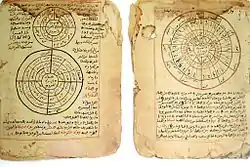
Muslims made several important improvements to the theory and construction of sundials, which they inherited from their Indian and Greek predecessors. Khwarizmi made tables for these instruments which considerably shortened the time needed to make specific calculations.
Sundials were frequently placed on mosques to determine the time of prayer. One of the most striking examples was built in the fourteenth century by the muwaqqit (timekeeper) of the Umayyad Mosque in Damascus, ibn al-Shatir.[86]
Quadrants
Several forms of quadrants were invented by Muslims. Among them was the sine quadrant used for astronomical calculations, and various forms of the horary quadrant, used to determine time (especially the times of prayer) by observations of the Sun or stars. A center of the development of quadrants was ninth-century Baghdad.[87] Abu Bakr ibn al-Sarah al-Hamawi (d. 1329) was a Syrian astronomer that invented a quadrant called “al-muqantarat al-yusra”. He devoted his time to writing several books on his accomplishments and advancements with quadrants and geometrical problems. His works on quadrants include Treatise on Operations with the Hidden Quadrant and Rare Pearls on Operations with the Circle for Finding Sines. These instruments could measure the altitude between a celestial object and the horizon. However, as Muslim astronomers used them, they began to find other ways to use them. For example, the mural quadrant, for recording the angles of planets and celestial bodies. Or the universal quadrant, for latitude solving astronomical problems. The horary quadrant, for finding the time of day with the sun. The almucantar quadrant, which was developed from the astrolabe.
Equatoriums
The Equatorium is an invention from Al-Andalus, by Al-Zarqali. The earliest known was made in the eleventh century.[88] It is a mechanical device for finding the positions of the moon, sun, stars and planets, without calculation using a geometrical model to represent the celestial body's mean and anomalistic position.
Astronomy in Islamic Art
_-_L'hammam_02.JPG.webp)
There are examples of cosmological imagery throughout many forms of Islamic art, whether that be manuscripts, ornately crafted astrological tools, or palace frescoes, just to name a few. Islamic art maintains the capability to reach every class and level of society.
Within Islamic cosmological doctrines and the Islamic study of astronomy, such as the Encyclopedia of the Brethren of Purity (alternatively called The Rasa'il of the Ikhwan al-Safa) there is a heavy emphasis by medieval scholars on the importance of the study of the heavens. This study of the heavens has translated into artistic representations of the universe and astrological concepts.[89] There are many themes under which Islamic astrological art falls under, such as religious, political, and cultural contexts.[90] It is posited by scholars that there are actually three waves or traditions of cosmological imagery, Western, Byzantine, and Islamic. The Islamic world gleaned inspiration from Greek, Iranian, and Indian methods in order to procure a unique representation of the stars and the universe.[91]
Examples

A place like Quasyr' Amra, which was used as a rural Umayyad palace and bath complex, coveys the way astrology and the cosmos have weaved their way into architectural design. During the time of its use, one could be resting in the bathhouse and gaze at the frescoed dome that would almost reveal a sacred and cosmic nature. Aside from the other frescoes of the complex which heavily focused on al-Walid, the bath dome was decorated in the Islamic zodiac and celestial designs.[90] It would have almost been as if the room was suspended in space. In their encyclopedia, the Ikhwan al' Safa describe the Sun to have been placed at the center of the universe by God and all other celestial bodies orbit around it in spheres.[89] As a result, it would be as if whoever was sitting underneath this fresco would have been at the center of the universe, reminded of their power and position. A place like Qusayr' Amra represents the way astrological art and images interacted with Islamic elites and those who maintained caliphal authority.
The Islamic zodiac and astrological visuals have also been present in metalwork. Ewers depicting the twelve zodiac symbols exist in order to emphasize elite craftsmanship and carry blessings such as one example now at the Metropolitan Museum of Art.[92] Coinage also carried zodiac imagery that bears the sole purpose of representing the month in which the coin was minted.[93] As a result, astrological symbols could have been used as both decoration, and a means to communicate symbolic meanings or specific information.
Notable astronomers
See also
- Astrology in medieval Islam
- History of astronomy
- List of Muslim astronomers
- List of Iranian scientists
Notes
- This book is not related to al-Khwarizmi's Zij al-Sindh. On zijes see E. S. Kennedy, "A Survey of Islamic Astronomical Tables".
References
Citations
- (Saliba 1994b, pp. 245, 250, 256–257)
- (Gingerich 1986)
- Leichter, Joseph (May 2004). The Zij as-Sanjari of Gregory Chioniades. Internet Archive. Providence, RI: Brown University (published 27 June 2009). Retrieved 11 November 2016.
- Saliba (1999).
- Benno, van Dalen (2002). Ansari, S.M. Razaullah (ed.). Islamic Astronomical Tables in China: The Sources for Huihui li. History of Oriental Astronomy. Astrophysics and Space Science Library. 274. pp. 19–32. doi:10.1007/978-94-015-9862-0. ISBN 978-94-015-9862-0.
- Holbrook, Jarita; Medupe, Rodney Thebe; Urama, Johnson O., eds. (1 January 2008). African Cultural Astronomy: Current Archaeoastronomy and Ethnoastronomy research in Africa. Springer Science & Business Media. ISBN 9781402066399. Retrieved 11 November 2016.
- Medupe, Rodney Thebe; Warner, Brian; Jeppie, Shamil; Sanogo, Salikou; Maiga, Mohammed; Maiga, Ahmed; Dembele, Mamadou; Diakite, Drissa; Tembely, Laya; Kanoute, Mamadou; Traore, Sibiri; Sodio, Bernard; Hawkes, Sharron (2008), "The Timbuktu Astronomy Project", African Cultural Astronomy, Astrophysics and Space Science Proceedings, 6, p. 179, Bibcode:2008ASSP....6..179M, doi:10.1007/978-1-4020-6639-9_13, ISBN 978-1-4020-6638-2.
- Arabic Star Names, Islamic Crescents' Observation Project, archived from the original on 2 February 2008, retrieved 11 November 2016
- Lebling, Robert W. (September–October 2010). "Arabic in the Sky". aramcoworld.com. Saudi Aramco World. pp. 24–33. Retrieved 11 November 2016.
- (Ilyas 1997)
- Dallal (1999), pg. 162
- Sachau, Edward, ed. (1910), Alberuni's India: An Account of the Religion, Philosophy, Literature, Geography, Chronology, Astronomy, Customs, Laws and Astrology of India about A.D. 1030, 1, London: Kegan Paul, Trench, Trübner, p. xxxi,
It was on this occasion [in the eighth century] that the Arabs first became acquainted with a scientific system of astronomy. They learned from Brahmagupta earlier than from Ptolemy.
- Dallal, Ahmad (2010). Islam, Science, and the Challenge of History. Yale University Press. p. 29. ISBN 978-0-300-15911-0.
- King, David A. (2005-06-30). In Synchrony with the Heavens, Studies in Astronomical Timekeeping and Instrumentation in Medieval Islamic Civilization: The Call of the Muezzin. 1. Brill Academic Pub. p. xvii. ISBN 978-90-04-14188-9.
And it so happens that the particular intellectual activity that inspired these materials is related to the religious obligation to pray at specific times. The material presented here makes nonsense of the popular modern notion that religion inevitably impedes scientific progress, for in this case, the requirements of the former actually inspired the progress of the latter for centuries.
- Berggren, J. L. (June 2007). "David A. King. In Synchrony with the Heavens: Studies in Astronomical Timekeeping and Instrumentation in Medieval Islamic Civilization. Volume 1: The Call of the Muezzin. (Studies I–IX.) 900 pp., index. Leiden/Boston: Brill Academic Publishers, 2004.David A. King. In Synchrony with the Heavens: Studies in Astronomical Timekeeping and Instrumentation in Medieval Islamic Civilization. Volume 2: Instruments of Mass Calculation. (Studies X–XVIII.) lxxvi + 1,066 pp., figs., apps., index. Leiden/Boston: Brill Academic Publishers, 2005". Isis. 98 (2): 378–379. doi:10.1086/521450. ISSN 0021-1753.
- Dallal (1999), pg. 163
- Dallal (1999), pg. 164
- Hoskin, Michael (1999-03-18). The Cambridge Concise History of Astronomy. Cambridge University Press. p. 60. ISBN 9780521576000.
- Ragep, F. Jamil (2001a), "Tusi and Copernicus: The Earth's Motion in Context", Science in Context, Cambridge University Press, 14 (1–2): 145–163, doi:10.1017/s0269889701000060
- Ragep, F. Jamil; Al-Qushji, Ali (2001b), Brooke, John Hedley; Osler, Margaret J.; van der Meer, Jitse M. (eds.), "Freeing Astronomy from Philosophy: An Aspect of Islamic Influence on Science", Osiris, 2nd Series, 16 (Science in Theistic Contexts: Cognitive Dimensions): 49–64 & 66–71, Bibcode:2001Osir...16...49R, doi:10.1086/649338
- Adi Setia (2004), "Fakhr Al-Din Al-Razi on Physics and the Nature of the Physical World: A Preliminary Survey", Islam & Science, 2, retrieved 2010-03-02
- Dallal, Ahmad S. (2010). Islam, Science, and the Challenge of History. United States: Yale University Press. pp. 31. ISBN 978-0-300-15911-0. Retrieved 11 November 2016.
- Saliba, George (September 1993). "Al-Qushjī's Reform of the Ptolemaic Model for Mercury". Arabic Sciences and Philosophy. 3 (2): 161–203. doi:10.1017/s0957423900001776. ISSN 0957-4239.
- Saliba, George (1994-02-01). "A Sixteenth-Century Arabic Critique of Ptolemaic Astronomy: The Work of Shams Al-Din Al-Khafri". Journal for the History of Astronomy. 25 (1): 15–38. doi:10.1177/002182869402500102. ISSN 0021-8286.
- E. S. Kennedy, "Al-Bīrūnī's Masudic Canon", Al-Abhath, 24 (1971): 59–81; reprinted in David A. King and Mary Helen Kennedy, ed., Studies in the Islamic Exact Sciences, Beirut, 1983, pp. 573–595.
- G. Wiet, V. Elisseeff, P. Wolff, J. Naudu (1975). History of Mankind, Vol 3: The Great medieval Civilisations, p. 649. George Allen & Unwin Ltd, UNESCO.
- Young, M. J. L., ed. (2006-11-02). Religion, Learning and Science in the 'Abbasid Period. Cambridge University Press. p. 413. ISBN 9780521028875.
- Bausani, Alessandro (1973). "Cosmology and Religion in Islam". Scientia/Rivista di Scienza. 108 (67): 762.
- Seyyed Hossein Nasr (1993), An Introduction to Islamic Cosmological Doctrines, pp. 135–136. State University of New York Press, ISBN 0-7914-1516-3.
- Hikmat al-'Ain, p. 78
- Toby E.Huff(1993):The rise of early modern science: Islam, China, and the West
- Samsó, Julio (1970–80). "Al-Bitruji Al-Ishbili, Abu Ishaq". Dictionary of Scientific Biography. New York: Charles Scribner's Sons. ISBN 978-0-684-10114-9.
- Samsó, Julio (2007). "Biṭrūjī: Nūr al‐Dīn Abū Isḥāq [Abū Jaʿfar] Ibrāhīm ibn Yūsuf al‐Biṭrūjī". In Thomas Hockey; et al. (eds.). The Biographical Encyclopedia of Astronomers. New York: Springer. pp. 133–4. ISBN 978-0-387-31022-0. (PDF version)
- Bernard R. Goldstein (March 1972). "Theory and Observation in Medieval Astronomy", Isis 63 (1), p. 39-47 [41].
- Ptolemaic Astronomy, Islamic Planetary Theory, and Copernicus's Debt to the Maragha School, Science and Its Times, Thomson Gale.(inaccessible document)
- Samsó 2007.
- Dallal (1999), pg. 171
- Subtelny, Maria E. (2010). "Tamerlane and his descendants: from paladins to patrons". In Morgan, David O.; Reid, Anthony (eds.). The New Cambridge History of Islam, Volume 3: The Eastern Islamic World, Eleventh to Eighteenth Centuries. Cambridge: Cambridge University Press. pp. 184–5. ISBN 978-0-521-85031-5.
- Chisholm, Hugh, ed. (1911). . Encyclopædia Britannica. 1 (11th ed.). Cambridge University Press. p. 491.
- Hoskin, Michael (1999-03-18). The Cambridge Concise History of Astronomy. Cambridge University Press. p. 58. ISBN 9780521576000.
- Freely, John (2015-03-30). Light from the East: How the Science of Medieval Islam Helped to Shape the Western World. I.B.Tauris. p. 179. ISBN 9781784531386.
- Hartner, Willy (1970–80). "Al-Battānī, Abū ʿAbd Allāh Muḥammad Ibn Jābir Ibn Sinān al-Raqqī al-Ḥarrānī al–Ṣābi". Dictionary of Scientific Biography. New York: Charles Scribner's Sons. ISBN 978-0-684-10114-9.
- Dalmau, W. (1997) CRITICAL REMARKS ON THE USE OF MEDIEVAL ECLIPSE RECORDS FOR THE DETERMINATION OF LONG-TERM CHANGES IN THE EARTH'S ROTATION Archived 2012-10-23 at the Wayback Machine', Surveys in Geophysics 18: 213-223.
- Samsó 1980.
- Roberts, V.; Kennedy, E. S. (1959). "The Planetary Theory of Ibn al-Shatir". Isis. 50 (3): 232–234. doi:10.1086/348774.
- Guessoum, N. (June 2008), "Copernicus and Ibn Al-Shatir: does the Copernican revolution have Islamic roots?", The Observatory, 128: 231–239 [238], Bibcode:2008Obs...128..231G
- A. I. Sabra (1998).
- E. S. Kennedy (Autumn 1966), "Late Medieval Planetary Theory", Isis, 57 (3): 365–378 [377], doi:10.1086/350144, JSTOR 228366
- Saliba, George (1995-07-01). A History of Arabic Astronomy: Planetary Theories During the Golden Age of Islam. NYU Press. ISBN 9780814780237.
- Swerdlow, Noel M. (1973-12-31). "The Derivation and First Draft of Copernicus's Planetary Theory: A Translation of the Commentariolus with Commentary". Proceedings of the American Philosophical Society. 117 (6): 424. Bibcode:1973PAPhS.117..423S. ISSN 0003-049X. JSTOR 986461.
- King, David A. (2007). "Ibn al‐Shāṭir: ʿAlāʾ al‐Dīn ʿAlī ibn Ibrāhīm". In Thomas Hockey; et al. (eds.). The Biographical Encyclopedia of Astronomers. New York: Springer. pp. 569–70. ISBN 978-0-387-31022-0. (PDF version)
- N.K. Singh, M. Zaki Kirmani,Encyclopaedia of Islamic science and scientists
- Viktor Blåsjö, "A Critique of the Arguments for Maragha Influence on Copernicus", Journal for the History of Astronomy, 45 (2014), 183–195 ADS.
- Claudia Kren, "The Rolling Device," p. 497.
- George Saliba, "Whose Science is Arabic Science in Renaissance Europe?"
- George Saliba (April 27, 2006). "Islamic Science and the Making of Renaissance Europe". Retrieved 2008-03-01.
- Goddu (2010, pp. 261–69, 476–86), Huff (2010, pp. 263–64), di Bono (1995), Veselovsky (1973).
- Veselovsky, I. N. (1973), "Copernicus and Nasir al-Din al-Tusi", Journal for the History of Astronomy, 4 (2): 128–30, Bibcode:1973JHA.....4..128V, doi:10.1177/002182867300400205, S2CID 118453340.
- Neugebauer, Otto (1975), A History of Ancient Mathematical Astronomy, 2, Berlin / Heidelberg / New York: Springer-Verlag, p. 1035, ISBN 978-0-387-06995-1
- Kren, Claudia (1971), "The Rolling Device of Naṣir al-Dīn al-Ṭūsī in the De spera of Nicole Oresme", Isis, 62 (4): 490–498, doi:10.1086/350791.
- Meuleman, Johan (30 September 2005). Islam in the Era of Globalization: Muslim Attitudes Towards Modernity and Identity. Routledge. ISBN 9781135788292. Retrieved 11 November 2016.
- Richard Bulliet, Pamela Crossley, Daniel Headrick, Steven Hirsch, Lyman Johnson, and David Northrup. The Earth and Its Peoples. 3. Boston: Houghton Mifflin Company, 2005. ISBN 0-618-42770-8
- Rufus, W. C. (May 1939), "The Influence of Islamic Astronomy in Europe and the Far East", Popular Astronomy, 47 (5): 233–238 [237], Bibcode:1939PA.....47..233R
- vande Walle, Willy (2003). vande Walle, W.F.; Golvers, Noel (eds.). The history of the relations between the Low Countries and China in the Qing era (1644-1911). Leuven University Press. p. 38. ISBN 978-90-5867-315-2. Retrieved 11 November 2016.
- van Dalen, Benno (2002), "Islamic Astronomical Tables in China: The Sources for Huihui li", in Ansari, S. M. Razaullah (ed.), History of Oriental Astronomy, Springer Science+Business Media, pp. 19–32 [19], ISBN 978-1-4020-0657-9
- Zhu, Siben; Walter Fuchs (1946). The "Mongol Atlas" of China. Taipei: Fu Jen Catholic University.
- Ho, Peng Yoke. (2000). Li, Qi, and Shu: An Introduction to Science and Civilization in China, p. 105. Mineola: Dover Publications. ISBN 0-486-41445-0.
- Yunli Shi (10 January 2002), "The Korean Adaptation of the Chinese-Islamic Astronomical Tables", Archive for History of Exact Sciences, 57 (1): 25–60 [26], doi:10.1007/s00407-002-0060-z, ISSN 1432-0657, S2CID 120199426
- Yunli Shi (January 2003), "The Korean Adaptation of the Chinese-Islamic Astronomical Tables", Archive for History of Exact Sciences, 57 (1): 25–60 [30], doi:10.1007/s00407-002-0060-z, ISSN 1432-0657, S2CID 120199426
- Baker, Don (Winter 2006). "Islam Struggles for a Toehold in Korea". Harvard Asia Quarterly. Archived from the original on 2007-05-17. Retrieved 2007-04-23.
- Yunli Shi (January 2003). "The Korean Adaptation of the Chinese-Islamic Astronomical Tables". Archive for History of Exact Sciences. 57 (1): 25–60 [26–7]. doi:10.1007/s00407-002-0060-z. ISSN 1432-0657. S2CID 120199426.
- John Morris Roberts, The History of the World, pp. 264–74, Oxford University Press, ISBN 978-0-19-521043-9
- El-Rouayheb, Khaled (2008). "The Myth of "The Triumph of Fanaticism" in the Seventeenth-Century Ottoman Empire". Die Welt des Islams. 48 (2): 196–221. doi:10.1163/157006008X335930.
- Richard Nelson Frye: Golden Age of Persia. p. 163.
- "Astrolabes in Medieval Cultures", Astrolabes in Medieval Cultures, BRILL, pp. 1–2, 2018-12-18, ISBN 978-90-04-38786-7, retrieved 2020-12-13
- Berggren, J. L. (June 2007). "David A. King. In Synchrony with the Heavens: Studies in Astronomical Timekeeping and Instrumentation in Medieval Islamic Civilization. Volume 1: The Call of the Muezzin. (Studies I–IX.) 900 pp., index. Leiden/Boston: Brill Academic Publishers, 2004.David A. King. In Synchrony with the Heavens: Studies in Astronomical Timekeeping and Instrumentation in Medieval Islamic Civilization. Volume 2: Instruments of Mass Calculation. (Studies X–XVIII.) lxxvi + 1,066 pp., figs., apps., index. Leiden/Boston: Brill Academic Publishers, 2005". Isis. 98 (2): 378–379. doi:10.1086/521450. ISSN 0021-1753.
- Berggren, J. L. (June 2007). "David A. King. In Synchrony with the Heavens: Studies in Astronomical Timekeeping and Instrumentation in Medieval Islamic Civilization. Volume 1: The Call of the Muezzin. (Studies I–IX.) 900 pp., index. Leiden/Boston: Brill Academic Publishers, 2004.David A. King. In Synchrony with the Heavens: Studies in Astronomical Timekeeping and Instrumentation in Medieval Islamic Civilization. Volume 2: Instruments of Mass Calculation. (Studies X–XVIII.) lxxvi + 1,066 pp., figs., apps., index. Leiden/Boston: Brill Academic Publishers, 2005". Isis. 98 (2): 378–379. doi:10.1086/521450. ISSN 0021-1753.
- Brentjes, Sonja (2013-09-18), "Safavid Art, Science, and Courtly Education in the Seventeenth Century", From Alexandria, Through Baghdad, Berlin, Heidelberg: Springer Berlin Heidelberg, pp. 487–502, ISBN 978-3-642-36735-9, retrieved 2020-12-13
- Chilton, D. (January 1959). "Elizabethan Navigation - The Art of Navigation in England in Elizabethan and Early Stuart Times. Lieut.-Commander David W. Waters, R.N. 696 + xi pp., 87 plates, 43 diagrams. London (Hollis & Carter), 1958. 84s. net". Journal of Navigation. 12 (1): 109–111. doi:10.1017/s0373463300045987. ISSN 0373-4633.
- Berggren*, J. L. (December 1991). "Medieval Islamic Methods for Drawing Azimuth Circles on the Astrolabe". Centaurus. 34 (4): 309–344. doi:10.1111/j.1600-0498.1991.tb00864.x. ISSN 0008-8994.
- Abbasi, Mubashir Ul-Haq (2014). "An Astrolabe by Muhammad Muqim of Lahore Dated 1047 AH (1637-38 CE)". Islamic Studies. 53.
- Castro, F (2015). "The Astrolabe Project". Journal of Maritime Archaeology. 10: 205–234.
- (Hill 1985)
- Tuncer Oren (2001). "Advances in Computer and Information Sciences: From Abacus to Holonic Agents", Turk J Elec Engin 9 (1): 63–70 [64].
- Verde, Tom (September 2011). "Saudi Aramco World :From Africa, in Ajami". saudiaramcoworld.com. Aramco World. Archived from the original on 2014-11-30. Retrieved 11 November 2016.
- David A. King, "Islamic Astronomy," pp. 168–9.
- David A. King, Islamic Astronomy, pp. 167–8.
- "Equatorium". Mistholme.
- Nasr, Seyyed Hossein (1964). An Introduction of Islamic Cosmological Doctrines. United States of America: The Belknap Press of Harvard University Press. pp. 75–77.
- Anderson, Benjamin (2017). Cosmos and Community In Early Medieval Art. New Haven and London: Yale University Press. pp. 63–69.
- Sardar, Marika. "Astronomy and Astrology in the Medieval Islamic World". metmuseum.org. Metropolitan Museum of Art. Retrieved 5 November 2019.
- "Ewer base with Zodiac medallions". metmuseum.org. The Metropolitan Museum of Art. Retrieved 5 November 2019.
- "Coin". www.metmuseum.org. Retrieved 2019-11-05.
- Hill, Donald Routledge, Islamic Science And Engineering, Edinburgh University Press (1993), ISBN 0-7486-0455-3
Sources
- Adnan, Abdulhak (1939), La science chez les Turcs ottomans, Paris
- Ajram, K. (1992), "Appendix B", Miracle of Islamic Science, Knowledge House Publishers, ISBN 978-0-911119-43-5
- Baker, A.; Chapter, L. (2002), "Part 4: The Sciences", Philosophia Islamica, in Sharif, M. M., "A History of Muslim Philosophy", Philosophia Islamica
- Covington, Richard, "Rediscovering Arabic science", Saudi Aramco World (May–June 2007 ed.), pp. 2–16
- Dallal, Ahmad (1999), "Science, Medicine and Technology", in Esposito, John (ed.), The Oxford History of Islam, Oxford University Press, New York
- Duhem, Pierre (1969) [First published 1908], To Save the Phenomena: An Essay on the Idea of Physical theory from Plato to Galileo, University of Chicago Press, Chicago, ISBN 978-0-226-16921-7
- Gautier, Antoine (December 2005), "L'âge d'or de l'astronomie ottomane", L'Astronomie (monthly magazine created by Camille Flammarion in 1882), 119
- Gill, M. (2005), Was Muslim Astronomy the Harbinger of Copernicanism?, archived from the original on 2 January 2008, retrieved 2008-01-22
- Gingerich, Owen (April 1986), "Islamic astronomy", Scientific American, 254 (10): 74, Bibcode:1986SciAm.254d..74G, doi:10.1038/scientificamerican0486-74, archived from the original on 2011-01-01, retrieved 2008-05-18
- Glick, Thomas F.; Livesey, Steven John; Wallis, Faith (2005), Medieval Science, Technology, and Medicine: An Encyclopedia, Routledge, ISBN 978-0-415-96930-7
- Hassan, Ahmad Y., Transfer Of Islamic Technology To The West, Part II: Transmission Of Islamic Engineering, archived from the original on 18 February 2008, retrieved 2008-01-22
- Hill, Donald R. (1985), "Al-Biruni's mechanical calendar", Annals of Science, 42 (2): 139–163, doi:10.1080/00033798500200141
- Hill, Donald R. (May 1991), "Mechanical Engineering in the Medieval Near East", Scientific American, 264 (5): 64–69, Bibcode:1991SciAm.264e.100H, doi:10.1038/scientificamerican0591-100 (cf. Hill, Donald R. (1989), Mechanical Engineering, ISBN 978-0-07-037863-6, archived from the original on 25 December 2007, retrieved 2008-01-22)
- Hill, Donald R. (1993), Islamic Science And Engineering, Edinburgh University Press, ISBN 978-0-7486-0455-5
- Huff, Toby (2003), The Rise of Early Modern Science: Islam, China, and the West, Cambridge University Press, ISBN 978-0-521-52994-5
- Ilyas, Mohammad (1996), Islamic Astronomy and Science Development: Glorious Past, Challenging Future, Pelanduk Publications, ISBN 978-967-978-549-4
- Iqbal, Muzaffar (2003), "Review: World-Maps for Finding the Direction and Distance to Mecca: Innovation and Tradition in Islamic Science by David A. King", Islam & Science, June 2003
- Iqbal, Muzaffar; Berjak, Rafik (2003), "Ibn Sina–Al-Biruni correspondence", Islam & Science, June 2003
- Kennedy, Edward S. (1947), "Al-Kashi's Plate of Conjunctions", Isis, 38 (1–2): 56–59, doi:10.1086/348036
- Kennedy, Edward S. (1950), "A Fifteenth-Century Planetary Computer: al-Kashi's "Tabaq al-Manateq" I. Motion of the Sun and Moon in Longitude", Isis, 41 (2): 180–183, doi:10.1086/349146, PMID 15436217
- Kennedy, Edward S. (1951), "An Islamic Computer for Planetary Latitudes", Journal of the American Oriental Society, 71 (1): 13–21, doi:10.2307/595221, JSTOR 595221
- Kennedy, Edward S. (1952), "A Fifteenth-Century Planetary Computer: al-Kashi's "Tabaq al-Maneteq" II: Longitudes, Distances, and Equations of the Planets", Isis, 43 (1): 42–50, doi:10.1086/349363
- Kennedy, Edward S. (1956), "A Survey of Islamic Astronomical Tables", Transactions of the American Philosophical Society, 46 (2): 123–177, doi:10.2307/1005726, hdl:2027/mdp.39076006359272, JSTOR 1005726
- Kennedy, Edward S. (1961), "Al-Kashi's Treatise on Astronomical Observational Instruments", Journal of Near Eastern Studies, 20 (2): 98–108, doi:10.1086/371617
- Kennedy, Edward S. (1962), "Review: The Observatory in Islam and Its Place in the General History of the Observatory by Aydin Sayili", Isis, 53 (2): 237–239, doi:10.1086/349558
- Kennedy, Edward S. (1998), Astronomy and Astrology in the Medieval Islamic World, Brookfield, VT: Ashgate, ISBN 978-0-86078-682-5
- King, David A. (1983), "The Astronomy of the Mamluks", Isis, 74 (4): 531–555, doi:10.1086/353360
- King, David A. (1986), Islamic mathematical astronomy, London, ISBN 978-0-86078-407-4
- King, David A. (1997), "Two Iranian World Maps for Finding the Direction and Distance to Mecca", Imago Mundi, 49 (1): 62–82, doi:10.1080/03085699708592859
- King, David A. (1999a), "Islamic Astronomy", in Walker, Christopher (ed.), Astronomy before the telescope, British Museum Press, pp. 143–174, ISBN 978-0-7141-2733-0
- King, David A. (1999b), World-maps for Finding the Direction and Distance to Mecca: Innovation and Tradition in Islamic Science, Brill Publishers, ISBN 978-90-04-11367-1
- King, David A. (2002), "A Vetustissimus Arabic Text on the Quadrans Vetus", Journal for the History of Astronomy, 33 (112): 237–255, Bibcode:2002JHA....33..237K, doi:10.1177/002182860203300302, S2CID 125329755
- King, David A. (December 2003), "14th-Century England or 9th-Century Baghdad? New Insights on the Elusive Astronomical Instrument Called Navicula de Venetiis", Centaurus, 45 (1–4): 204–226, doi:10.1111/j.1600-0498.2003.450117.x
- King, David A. (2004), "Reflections on some new studies on applied science in Islamic societies (8th–19th centuries)", Islam & Science, June 2004
- King, David A. (2005), In Synchrony with the Heavens, Studies in Astronomical Timekeeping and Instrumentation in Medieval Islamic Civilization: Instruments of Mass Calculation, Brill Publishers, ISBN 978-90-04-14188-9
- King, David A.; Cleempoel, Koenraad Van; Moreno, Roberto (2002), "A Recently Discovered Sixteenth-Century Spanish Astrolabe", Annals of Science, 59 (4): 331–362, doi:10.1080/00033790110095813, S2CID 144335909
- Langermann, Y. Tzvi, ed. and trans. (1990), Ibn al-Haytham's On the Configuration of the World, Harvard Dissertations in the History of Science, New York: Garland, ISBN 978-0-8240-0041-7
- Marmura, Michael E.; Nasr, Seyyed Hossein (1965), "Review: An Introduction to Islamic Cosmological Doctrines. Conceptions of Nature and Methods Used for Its Study by the Ikhwan Al-Safa'an, Al-Biruni, and Ibn Sina by Seyyed Hossein Nasr", Speculum, 40 (4): 744–746, doi:10.2307/2851429, JSTOR 2851429
- Marshall, O. S. (1950), "Alhazen and the Telescope", Astronomical Society of the Pacific Leaflets, 6 (251): 4, Bibcode:1950ASPL....6....4M
- Morrison, James E. (2007), The Astrolabe, Janus, ISBN 978-0-939320-30-1
- Nasr, Seyyed H. (1993), An Introduction to Islamic Cosmological Doctrines (2nd ed.), 1st edition by Harvard University Press, 2nd edition by State University of New York Press, ISBN 978-0-7914-1515-3
- Ragep, F. Jamil (2001a), "Tusi and Copernicus: The Earth's Motion in Context", Science in Context, 14 (1–2): 145–163, doi:10.1017/s0269889701000060
- Ragep, F. Jamil (2001b), "Freeing Astronomy from Philosophy: An Aspect of Islamic Influence on Science", Osiris, 2nd Series, 16 (Science in Theistic Contexts: Cognitive Dimensions): 49–64 & 66–71, Bibcode:2001Osir...16...49R, doi:10.1086/649338
- Ragep, F. Jamil; Teresi, Dick; Hart, Roger (2002), Ancient Roots of Modern Science, Talk of the Nation (National Public Radio discussion; astronomy is discussed in the first fifteen-minute segment), archived from the original on 1 January 2008, retrieved 2008-01-22
- Rashed, Roshdi; Morelon, Régis (1996), Encyclopedia of the History of Arabic Science, 1, & 3, Routledge, ISBN 978-0-415-12410-2
- Rashed, Roshdi (2007), "The Celestial Kinematics of Ibn al-Haytham", Arabic Sciences and Philosophy, 17 (1): 7–55, doi:10.1017/S0957423907000355
- Rosen, Edward (1985), "The Dissolution of the Solid Celestial Spheres", Journal of the History of Ideas, 46 (1): 13–31, doi:10.2307/2709773, JSTOR 2709773
- Sabra, A. I. (1998), "Configuring the Universe: Aporetic, Problem Solving, and Kinematic Modeling as Themes of Arabic Astronomy", Perspectives on Science, 6: 288–330
- Saliba, George (1979), "The First Non-Ptolemaic Astronomy at the Maraghah School", Isis, 70 (4): 571–576, doi:10.1086/352344
- Saliba, George (1980), "Al-Biruni", in Strayer, Joseph (ed.), Dictionary of the Middle Ages, 2, Charles Scribner's Sons, New York
- Saliba, George; Sezgin, F. (1981), "Review: Geschichte des arabischen Schriftiums. Band VI: Astronomie bis ca. 430 H by F. Sezgin", Journal of the American Oriental Society, 101 (2): 219–221, doi:10.2307/601763, JSTOR 601763
- Saliba, George (1994a), "Early Arabic Critique of Ptolemaic Cosmology: A Ninth-Century Text on the Motion of the Celestial Spheres", Journal for the History of Astronomy, 25 (2): 115–141, Bibcode:1994JHA....25..115S, doi:10.1177/002182869402500205, S2CID 122647517
- Saliba, George (1994b), A History of Arabic Astronomy: Planetary Theories During the Golden Age of Islam, New York University Press, ISBN 978-0-8147-8023-7
- Saliba, George (1999), Whose Science is Arabic Science in Renaissance Europe?, Columbia University, archived from the original on 15 January 2008, retrieved 2008-01-22
- Saliba, George (2000), "Arabic versus Greek Astronomy: A Debate over the Foundations of Science", Perspectives on Science, 8 (4): 328–341, doi:10.1162/106361400753373713, S2CID 57562913
- Saliba, George (2007), Lecture at SOAS, London – Part 3/7, Muslim Heritage & YouTube, retrieved 2008-01-22
- Singer, C. (1959), A Short History of Scientific Ideas, Oxford University Press, ISBN 978-0-19-881049-0
- Suter, H. (1902), Mathematiker und Astronomen der Araber
- Tabatabaei, Seyyed Muhammad Husayn, Tafsir al-Mizan
- Wickens, G. M. (1976), "The Middle East as a world Centre of science and medicine", in Savory, Roger M. (ed.), Introduction to Islamic Civilization, Cambridge University Press, pp. 111–118, ISBN 978-0-521-09948-6
